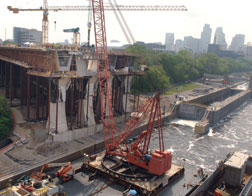 AP/WideWorld
Minnesota’s new I-35W bridge was alluded to as example of controversial selection process.
|
The Engineers’ Society of Western Pennsylvania, the IBC organizers, hoped to attract more contractors and introduced new sessions specifically with that purpose. At one session, the contractor panel repeatedly urged there be no more than three teams on prequalified short lists, to encourage contractor innovation, allocate reasonable risk and solicit one-on-one meetings. “We won’t likely bid on a job if there are more than three teams shortlisted,” said Robert H. Luffy, president and chief operating officer of American Bridge Co., Coraopolis, Pa.
Contractors in today’s market are able to pick and choose jobs, and Ralph Salamie, business development manager for Kiewit Pacific Co., Vancouver, Wash., likened the bidding process to a “courting period” in which the owner must woo the contractor. He urged owners to conduct one-one-one meetings with short-listed team leaders to solicit feedback on proposals and make clear what they want.
“Establish a clear vision,” said Salamie. “Be clear on the deal-killers.”
The group—which included G.M. “Pat” Stricklin, president of GMS Consulting Inc., Meridian, Idaho; Patrick Flaherty, senior vice president for infrastructure with Fluor Enterprises Inc., Greenville, S.C.; and Brian Reynolds, vice president with Zurich North America, stressed the need for a fair, transparent and clearly communicated selection process, using an “anonymous” example that appeared to be the controversial bid selection process for the new Interstate 35W bridge in Minnesota.
They noted that the winning bid was for a concrete bridge and had the longest schedule and highest price. All other proposals were for steel. Luffy advised owners in general to “be open and forthright. Make the teams aware of what you want.”
In other sessions, contractors gave their perspectives in sessions on accelerated bridge construction (ABC), a major theme championed by the Federal Highway Administration. Utah Dept. of Transportation officials said accelerated bridge construction was “almost standard practice” now. ABC, for UDOT, includes design-build project delivery and use of prefabricated or precast elements.
Engineers also emphasized inspection and research on structural failures. William Wright, team leader for bridge design and construction research at FHWA’s Turner-Fairbank Highway Research Center, announced the kickoff of a one-year, fast-track research program on gusset plates, now believed to be a key factor in the collapse. The $1-million program will include large-scale experiments and aims to “develop more accurate design and rating provisions for major trusses,” said Wright.
With both compression and tension forces involved, “gussets are more complicated than we'd like to think,” he said. By providing retrofit recommendations, the study results could help owners avoid unnecessary costs, he added.
ridge designers and engineers face increasing pressure to build and rehabilitate structures faster and more durably than ever. The 25th annual International Bridge Conference, held June 2-4 in Pittsburgh, highlighted as key issues contractor relationships in alternative project-delivery teams and high-tech, “hyperbuild” solutions.

Post a comment to this article
Report Abusive Comment